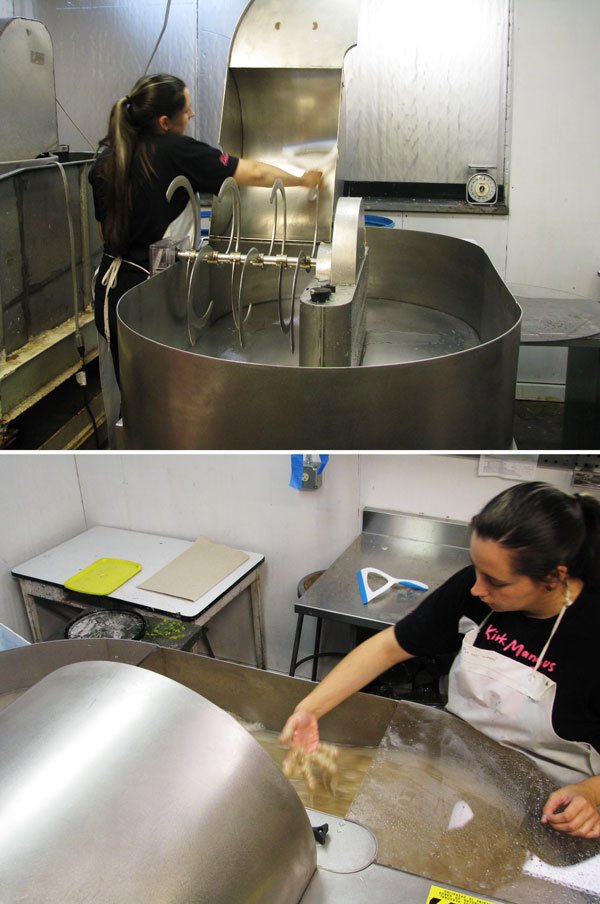A New Naginata Beater, in Cleveland!
Naginata Beater - Hand Papermaking Equipment - David Reina
"A New Naginata, in Cleveland" is a guest article by Aimee Lee, interdisciplinary artist, Fulbright fellow, and author of Hanji Unfurled: One Journey into Korean Papermaking. Aimee recently oversaw the creation and arrival of a stainless-steel naginata beater, built by David Reina Designs, to The Morgan Conservatory. A naginata beater is similar to a hollander beater, but generally used in Eastern style hand papermaking to process long fibers such as kozo. The difference is that a naginata has long, thin, rotating blades that tease the fibers apart. The resulting paper sheet is remarkably even. One of the few naginatas in the United States, this piece of papermaking equipment is a game changer!
In 2014, Cleveland's Morgan Conservatory was granted project support from Cuyahoga Arts & Culture to launch the Eastern Paper Studio (EPS). This initiative supports Asian paper traditions through workshops, an annual kozo harvest, on and off-site classes, dedicated exhibits, apprentice training, and paper production for sale.
In 2010, I collaborated with the Morgan to create the Anne F. Eiben Hanji Studio, the only Korean papermaking facility in North America. This was the foundation to support more types of Eastern papermaking, and Artistic Director Tom Balbo's vision to plant Japanese kozo (paper mulberry) trees in the Morgan's urban lot, which grew into the Caraboolad Garden. This garden cultivates plants necessary for papermaking and dyes, making the Morgan the only non-academic U.S. site that can teach root-to-sheet papermaking.
Until now, we processed all fiber by hand, a.k.a., hours of beating with wooden mallets. Though hand beating is a key step in Eastern papermaking, we lacked the manpower to process the volume necessary for large production and classes. Our dream was to build both stamper and naginata beaters, but on our budget and timeline, opted for the naginata first.
After viewing Tim Barrett's naginata in Iowa City, Tom suggested that we contact beater genius David Reina, who was up to the challenge. Unlike his usual Hollander beaters, which contain a bedplate and roll with parallel blades to cut fibers short, the naginata beater was designed with no bedplate and far fewer blades. These are paired and sickle shaped (named after curved swords used by Japanese warriors), lined up in the direction of the water flow. They are not sharp to the touch (unlike Hollander blades), and tease long strands apart to leave fiber length intact but allow for more even dispersion in the vat. The usual Hollander beat time is usually measured in hours; the maximum beat time in a naginata is 15 minutes.
Dave consulted with Tim to build the first stainless steel naginata in the U.S. Our lead donor Lisa Cirando and I visited after he assembled the machine, with two pounds of lightly hand beaten Thai kozo in a bucket that I carried to Brooklyn for its maiden voyage. Miraculously, the simple motion of the blades was enough to circulate the entire trough of slurry, and Lisa went home with a bucketful of freshly beaten fiber.
A couple weeks later, the naginata arrived at the Morgan in its custom crate. A pallet jack took it to its new home in the beater room, and it has since run gampi and more kozo, with much more to come.
This machine (as yet unnamed!) has already sped up workshop prep and paper production. After so many months of naginata talk, it's hard to believe that it is really here! We are especially grateful to Dave for making it, Tim for his advice and encouragement, Lisa for making our dreams come true, and everyone at the Morgan for supporting Eastern papermaking.
Visit the Morgan to see the naginata—better yet, come before September 20, 2014 to view "Revive and Renew", the current exhibit of contemporary artists who use Eastern papers, fibers, and materials. A few batches of naginata-beaten EPS papers are available for sale alongside hand and Hollander beaten counterparts in an array of sizes, colors, and fibers.
Best times to visit The Morgan Conservatory:
Through September 20, 2014: Revive and Renew: Contemporary Artists & Eastern Papers
October 11, 2014: Annual Benefit: Mulberry Madness
November (date TBA, pending hard frost): Annual Kozo Harvest—come ready to work! Help us steam, strip, and scrape Morgan kozo from our garden. Enjoy company, complimentary veggie chili, and the great urban outdoors while volunteering for a wonderful non-profit. For more info, contact program@morganconservatory.org.
by Aimee Leewww.aimeelee.net






